According to Carers Australia, a carer (sometimes referred to as an informal carer) is a person who provides unpaid care or support to a friend or family member who requires assistance due to age, mental or terminal illness, a chronic condition, alcohol or other drug use or who have a disability (Carers Australia, 2023).
Carers may live with the person they are caring for or they may visit the person regularly.
In culturally diverse communities, the responsibility for caring may lay with the whole community. This may present additional challenges during the process of identifying the carer/s.
Activity – Scenario and questions
Ricardo lives in a block of flats. He is in his 50s and holds down a full time job. Ricardo has an arrangement with his elderly neighbour that if the blind is up on the kitchen window everything is OK. When Ricardo comes home after work, he goes over to his neighbours about 8.00pm each night to have a night cap with them. This is Ricardo’s way of making sure his neighbour does not need him to get him anything from the shops and to check he is still managing.
Refer to and follow the links for ‘Am I a carer?’ to answer the following questions.
Questions
Is Ricardo a carer?
What criteria did you use to determine your answer?
Post your response online or discuss with your trainer or colleagues.
The following are some statistics about carers in Australia (Carers Australia, 2023ABS 2019, Deloitte Access Economics 2020).
- In 2020 it was estimated there were about 2.8 million informal carers across Australia
- These carers were comprised of 906,000 primary carers and 1.9 million non-primary carers representing an increase of 5.5% in the number of carers as a result of population growth since 2018 ABS research findings
- Primary carers (person most involved in day to day care) spent on average of 35.2 hours providing unpaid care – 28% spent more than 60 hours per week; 25% spent about 1 to 9 hours per week.
Carers can come from socio-economic backgrounds, gender, age groups and cultural backgrounds. Carers should be given the support that recognises and responds to their individual needs and background.
According to the latest Survey of Disability, Ageing and Carers (SDAC) (2018):
- Approximately seven (7) out of ten (10) primary carers are women
- One in eleven (11) carers are under the age of 25 years
- About 70% of primary carers stated their sense of family responsibility was the reason they took on a caring role.
Carers and the people they care for can identify with the following groups:
- Older people
- Younger people
- Aboriginal and Torres Strait Islander people
- Lesbian, gay, bisexual, transgender and intersex communities (LGBTIQA+)
- Culturally and linguistically diverse communities (CALD).
It is estimated (Carers Australia) that between 25% to 30% of all Australian carers are from CALD backgrounds. These carers often experience barriers to accessing carer payments or carer allowances which in turn can impact on health and wellbeing. According to Carers Australia, these barriers may include:
- Cultural rules relating to how an older person or person with a disability is looked after
- Concerns about culturally appropriate services
- Lack of awareness of services or inability to contact services due to language barriers.
Aboriginal and Torres Strait Islanders provide unpaid care and support to family and friends who may have a disability, terminal illness, chronic condition or who are frail aged. According to Carers Australia, 12.4% of the Aboriginal and Torres Strait Islander population are carers as compared to 10.5% of the non-indigenous Australians.
Aboriginal and Torres Strait Islander carers in rural or remote areas of Australia can experience:
- Lack of information
- Geographic barriers in accessing health and welfare services Social isolation
- Lack of transportation
- Language and cultural barriers
- Fewer opportunities for training and education about caring and government support (Carers Australia 2023).
It is expected there will be increased pressure placed on informal carers as Australia’s population ages. Some of the current informal carers will be requiring assistance themselves resulting in a downward shift in the supply of carers with an increase in demand. Additionally, increases in life expectancy may not correspond with the quality of life and this in turn will put added burdens on carers (Deloitte Access Economics 2020).
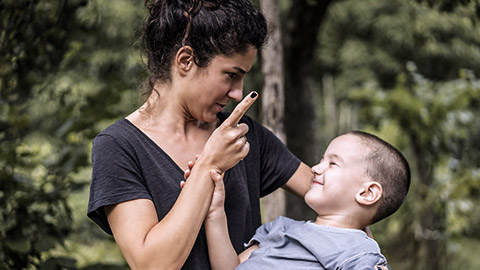
Assumptions about, attitudes towards, spreading myths, stereotyping and believing things that are not true about carers can damage their reputation. In some cases, because they feel they are not wanted or valued, they withdraw from socialising activities or see themselves as not valuable members of the community. This can lead to isolation or depression.
Assumptions
An assumption is a belief a person holds without testing or discovering more about it.
It is often assumed that:
- A carer or family member will always be there to take on increasing responsibility for care of a person as it is needed or health and emotional situations of a partner or spouse changes.
- Providing care is just about people with disabilities.
- So long as there is funding available, the job of caring for others is taken care of.
- Professional care workers will fill any gaps an informal carer cannot do.
- Informal carers and family members have infinite patience to work with a person who needs their care.
- Informal carers never get tired or burnt out.
These types of assumptions about caring need to be explored and government policy flexible enough to be able to meet the changing needs of the carer, family members and people needing care.
Attitudes about caring for others
Attitudes about caring for others varies from carer to carer, family to family and from the person needing care. For instance:
- Some carers want to care for other people; others feel it is their duty to do so
- Some people welcome the time and effort a carer puts into helping them with daily living; others are angry that they need help
Attitudes towards care can change as life changes occur, health deteriorates or personality changes.
Community and social attitudes towards care can be positive or negative. For example: Carers have a challenging job; carers will never be able to have an enjoyable life.
Some carers do not always want to let others know they are in a caring role. This may be because of community attitudes associated with disability or mental illness.
Stereotyping
Stereotyping is a preconceived idea about a person, group of people or thing that is often unfair or untrue (Vocbulary.com 2023).
Examples of stereotyping associated with caring:
- There are more females involved with caring for older people or family members than males
- All carers are susceptible to stress
False belief

A false belief is based on a false understanding or misconception drawn from incorrect reasoning.
Two false beliefs about caring:
- There is no support for carers and family members; it is only available for the person who needs the care.
- A carer should only have positive thoughts about caring for someone they love, put the person needing care first at all the time and put their own needs on the backburner.
Myth
A myth is something that is unproved or a collective belief by a group of people that justifies a social position, religious belief, work ethic or activity or social custom.
Examples of myths associated with caring:
- All carers are paid workers who go to a person’s house to help them with daily shopping, cleaning and personal hygiene.
- All carers have good health and wellbeing.
- The person needing care will lose their independence when a support person comes into the home to help
With increased research about carers and their role in working with people who need care, more transparency in the media and on social media and government interventions, assumptions, false beliefs, stereotyping, and myths are slowly being eroded.
There is more understanding about carer needs and what they do. Negative attitudes from the community towards supporting carers in their role is gradually changing to be more helpful.
Carers are also realising they are people who have their own needs and wants and there are ways they can be met. Research by Carers Australia also highlight carers are beginning to share how they feel about caring for others and to realise they can give themselves permission to have these feelings.
Activity – Discussion
Identify one:
- attitude
- stereotype
- false belief
- myth
associated with caring activities.
Post your findings online or discuss with your trainer or a colleague.
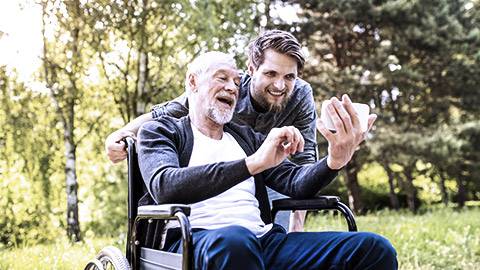
Carers and family members play a key role in caring for and supporting persons of an older age.
A carers involvement will depend on:
- the nature of the person’s need and
- the level of support required.
The way in which carers are involved with the person also affects how the person being cared for can access systems and services. The carer may be in the position of:
- acting as a guide
- providing transport
- being required to be appointed as a nominee for the purposes of Centrelink or banking
- being formally appointed as a guardian, administrator or power of attorney.
A carer should be recognised and respected as a person:
- in their own right
- with their own needs
- who has the knowledge about the person they care for
- contributing to the community as a direct result of their care role.
Carers Recognition Act 2012
The Carers Recognition Act 2012 recognises, promotes and values the role of carers.
Activity – Research
Access and read the fact sheet: What the Carers Recognition Act 2012 (Vic) says about supporting people in care relationships and answer the questions that follow.
Questions
What are the three care relationship principles?
What can a carer expect to have recognised by a support organisation?
Post your responses online or discuss with your trainer or colleagues
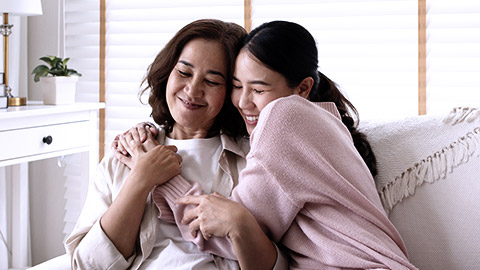
Family roles and relationships are an important part of the life of the person needing care. It will differ between families as will the dynamics of how members of the family relate to each other. You only need to think about your own family and that of your friends or relatives to see how differently members of families support and interact with each other.
Each family member will view family from a different perspective, and this can grow and/or change as they move through life.
Working effectively with carers can be enhanced by:
- gaining an understanding of the person requiring care and support
- observing and understanding their family relationships
- being aware of the dynamics between family members
- understanding the role and place of friends or others outside the family
- being mindful of the position the carer holds with the person needing care and with other family members.
Family structures
Family structure refers to the relationship configuration of the individuals living within a household and how they see themselves as a family.
A family shares goals, responsibilities, emotional bonds and common values. They contribute to the well-being of each other.
Families can be of any size from no children to one or two children to four or more children.
As societal norms change, so too do the definitions of a family and the acceptance of different family structures.
In Australia, there are many different ways in which families are structured. Some of the structures* you might encounter follow.
| Nuclear family | Comprises mother and father or partners (married) or same or opposite sex defacto and child/children who are biological or adopted |
|---|---|
| Single parent | Widowed, divorced, never marries with children |
| Extended family |
Comprises of two or more adults related through marriage or blood (aunts, uncles, cousins, grandparents), usually with child/children living under the same roof. Aboriginal and Torrest Strait Islander culture has an extended family structure. Extended faimilies are more common in migrant households |
| Childless family | Made up of two partners who cannot or do not want children |
| Blended family | Comprises two separate families merging into one, for example, two divorced parents with one or more children blending families; one divorced parent with child/children marrying someone who has never married or had children |
| Grandparent family | One or more grandparent raising their grandchild/children where, for example, parents are too young to provide for child/children, there is a substance disorder, or the death of both parents |
| Chosen family | eople choose to be a part of a family circle but are not biologically related to them |
| Kinship | Aboriginal and Torres Strait Islander peoples' family structure is based on kinship which structures relationships, obligations, and behaviours of their people. It also influences marriage, death, responsibilities, misdeeds, and who cares for the elderly or sick. |
Not all Australians live in extended families. Some parents who are aging might live in their own home or in homes that care for older people.
Both internal and external factors influence family members.
| Internal factors | External factors |
|---|---|
|
|
Carer’s relationship with person with support needs
The carer’s interactions with a person needing care can vary depending on their relationship with the person. The carer maybe someone from the person needing care’s:
- Immediate family (parent, spouse/partner, child, sibling)
- Extended family (uncle, aunt, grandparent, niece, nephew, cousin
- Outside the household (friend, neighbour)
You must be aware of the relationships and interactions and work within the boundaries of the relationship.
| Person | Role and responsibility |
|---|---|
| Family members | Family members have the right to expect support and services to be provided to the person needing care in an equitable and fair manner. They have a responsibility to share information with service providers following privacy requirements and consent of the person needing care and conversely receive information about care support in an accessible way. They also have a responsibility to support safe work practices in the home. |
| Friends | A friend’s role is usually not a formal one. They can make their own choices as to how they may support the person who is being cared for and commit to the relationship. Friends offer social and recreational support and friendship. Friends may be providing unpaid care to a person, and in this instance, you may need to explore with your coordinator whether they have the right to receive support as a carer. |
| Support worker |
As a support worker, you have the responsibility of carrying out your work tasks:
|
The views of the person being cared for, the family members and the carer must always be considered.
To help you as a support worker to work positively with the person needing care, learn as much as you can without being intrusive about:
- the person requiring a carer
- the support needs of the person requiring a carer
- the person requiring care and the family’s expectations of the role of the carer
- the day-to-day task commitments of the carer
- the person requiring care and the family’s expectations of the role of the support worker
- the family dynamics and family relationships
- the stability of the current situation and the potential for change
- the current roles and situation of family members or carers and any potential for change.
Once you have established the existing role of the carer and/or family member you can work out what you will be required to perform or help within the overall care plan for the person needing care.
Finding out as much as possible about the person requiring care, the carer themselves, and the family relationships and dynamics means you:
- Respect and acknowledge the role of the carer or the family member in the life of the person receiving care.
- Can carry out and meet the needs of the person needing care that are unable to be met by the carer.
- Are able to work in the best way with the carer or family member and minimise stepping on anyone’s toes or duplicating the meeting of the client’s needs.
- Complement the existing role of the carer or family member.
Activity – Case studies and questions
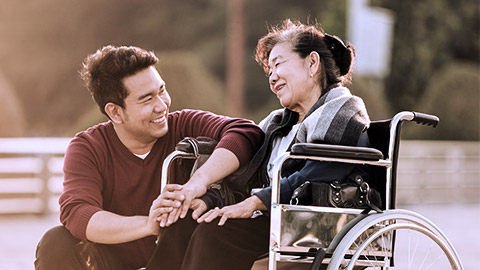
Case study 1
Ms Lyon, 85 years old, lives on her own in a lifestyle village. You have been visiting Ms Lyon for some time now. On this particular occasion, you arrive to find Ms Lyon’s son visiting his mother. On asking Ms Lyon how she feels she says bit sore and asks you to look at the bruise on her ankle. You ask how she thinks she got it and she says: ‘I fell. Old people just fall and that’s how it is.’ Her son mumbles on the side that he took her to emergency last week as she fell in the shower. He adds that she seems to be falling more regularly for no apparent reason and he is becoming concerned since she lives on her own, although she does have an emergency call button. He adds though that she takes it off at night as she rolls over and knocks on the call button.
Case study 2
You visit Mr A in his home each day. He is in his early 90s and quite frail. Recently, his daughter and son-in-law with their two children moved in with him as they had nowhere to go after the property they were renting was sold. The family seem very nice and speaks highly of Mr A. They always offer you a coffee and share some of the activities they have been doing. They suggest that they can look after him and that you cut down your visits to about once a week to see to his needs.
On this particular morning, you arrive a little early. You hear yelling and swearing through the door. You ring the bell, and the daughter answers the door. She is looking a little tired but is all smiles and invites you in to see Mr A. She leaves you alone asking if you mind if she goes to the shops. No one else is home. Mr A confides in you that things are quite difficult financially and he is a bit afraid of his son-in-law.
On leaving the house, a neighbour pokes her head over the fence and bales you up saying: ‘Are you going to do anything about it? They are always yelling and swearing. Mr A is becoming quite depressed and doesn’t even want to have a coffee with me anymore.
Case study 3
Mr and Mrs C live in a small unit. They moved in when they were in their 60s planning for the future when they were not so mobile. Their unit is on the 5th floor and accessible by a lift. Both are now in their 80s. Mr C is not so mobile any more and has developed a fear of falling so wants to just sit at home and read. His wife is still quite active and social and wants to go out more. Their daughters live in another state. Mrs C often calls one or the other daughter to talk about Mr C as she is very worried about him getting depressed and also leaving him alone in case he falls. She does so in another room in whispers in case he hears. Her daughters have suggested she talk to you during one of your visits.
Case Study 4
Mr P lives with his wife in a small town. For some time now, the people at the community activity centre have noticed he has scratches on his face, hands and arms. Mr P always has a flippant answer to why the scratches are there. Being a small town, the people also know Mr P is the sole carer for his wife for the last 40 years. You have been asked to visit him to give him and his wife support after he presented at a hospital emergency with several fractures in one of his arms.
After visiting several times over the next months while he heals, you discover his wife is suffering from Alzheimer’s disease and has recently become aggressive and telling him ‘you are not my husband! Get away from me…’.
Mr P did not know this behaviour was part of her illness and was protecting her.
Questions
What is the family and/or friend dynamic in each case study?
What is the impact of the relationship between the carer, family members and/or person in care?
How would you resolve the issue as you see it?
Post your response online or discuss it with your trainer or colleague
Communicating with carers, family and person needing care
Using effective communication skills when working with carers, the family members and the person needing the care will enable you to find out about them in a way that is non-judgemental and inclusive and shows your interest and care in the person.
Use active listening skills. Pay attention when someone is talking to you and don’t interrupt or jump to conclusions about what they might be going to say.
Reflect on the content and ask open questions to find out more information. Remember a closed question is usually answered with a yes, no, or maybe which doesn’t give you must information to work on.
Show you understand any underlying emotion. You might say something like: ‘I would feel great after walking on the beach too, especially since ……..’
Clarifying role and responsibilities
Clarify your responsibilities with all people involved in the care support team and ensure you do not work outside:
- the agreed tasks with the carer, family members and/or person needing care
- your job boundaries and job description
- organisational policy and procedures
- care support team and coordinator’s direction and agreed on actions
- tasks you are qualified to undertake
- legal requirements and limitations.
Entering the home of a person needing care
When entering a client’s home, remember it is not your workplace. It is the person who you are caring for and usually the carer’s home as well. It is their life.
Respect their belongings and the way they live their life. Be caring but non-judgemental of the way they live and conduct their life.
Keep in mind they are experts on their needs, their stressors and what might have taken place since your last visit or before your first visit.
Sometimes nothing has changed and all you need to do is listen or just be there in a quiet time.
Always start the day with including them in a conversation about how they are, if there are any changes you need to know about or what has been happening. It is respectful to listen to their responses and not make assumptions about what might or might not have occurred.

Carers will need to draw on a range of general skills to undertake their role including, but not limited to:
- Communication skills
- Time management
- Interpersonal and relationship skills
- Problem-solving skills
- Compassion
- Empathy
- Negotiation skills
- Need identification skills
Often these skills and knowledge will come from:
- their own experiences
- attending information or training activities
- information from health care providers and support organisations.
Practical tasks, skills and knowledge a carer or family member may typically need to develop over the course of their caring role, but are not limited to providing, include:
- Daily or weekly household tasks e.g. cleaning, cooking, buying groceries or personal items
- Providing transport and aid for shopping activities or well being appointments
- Emotional support e.g. being a friend, listening
- Social support e.g. transport to clubs or social outlings
- Physical and personal care e.g. dressing, lifting, bathing, toiletring, feeding
- Health care and medical support e.g. managing medication, attending medical appointments, first aid, manual handling, technical expertise relevant to conditions of person in care
- Advocacy e.g. listen to concerns, speak up on behalf of person needing care, help to understand and navigate aged care services or fees
- Filling in forms
- Financial support e.g. aiding in banking appointments or paying accounts
- Organising additional care service
It should also be recognised that through no fault of their own, some carers are often unprepared to deal with emergencies or changing situations as a result of rapidly deteriorating circumstances of the person they are caring for.
It is important, therefore, to be cognizant of any gaps or needs that may be, or may in the future, cause additional stress for the carer. Be prepared to work with the carer or direct them to training programs that can provide the skills to deal with the circumstances required.
As support worker should also recognise and acknowledge where the skills, knowledge and experiences the carer has complements your own.
Recognise that as a care worker you have limited resources and time to provide the care and support of the person needing care by yourself. Without family and friend support, your client may struggle to live in the community as they wish.
Part of your role is to support the carer as well as the person requiring care. You might simply ask: ‘how are you doing today?’ or you might observe the carer is unwell, tired or short tempered.
Where this behaviour is observed, you will need to follow your organisations procedures. In most cases you might need to refer to or confirm your concerns to your coordinator before taking any action.
It is also important to protect yourself. If at any time you feel upset at what you experience or see, report and discuss with your coordinator. Take care of yourself and be aware of your own attitudes and biases. If you do not debrief, or work through your own emotions and concerns, it may affect the way in which you behave or react with the person needing care, their carers and/or family members.
Activity – Case study and questions
Read the following scenario and answer the questions that follow.
Case study

Rhiana is a single mother, with two children aged six and nine.
A change in financial and family circumstances has meant Rhiana’s parents have moved in with her. Her father’s memory was failing at the time after a major heart operation. Although Rhiana’s mother has been helping with her father’s care over the last few years, she is now at an age where she is able to do less and less in terms of physical and emotional support.
Rhiana’s father’s ability to think clearly and his memory is continuing to fail. Often, he finds the children’s play upsetting and tells them to go away. Rhiana has to help with his care, including medicating, more and more.
Rhiana loves her parents and wants to look after them, but she is now in a situation where she is tired, cries easily at the least thing and sleeps badly. She finds herself yelling at the children for no reason and this is upsetting to both her and the children.
Questions
Who is the carer in this situation?
You report your concerns to your coordinator. What action might you suggest to your coordinator in this situation to support the carer?
Post your comments online or discuss them with your trainer or colleague.
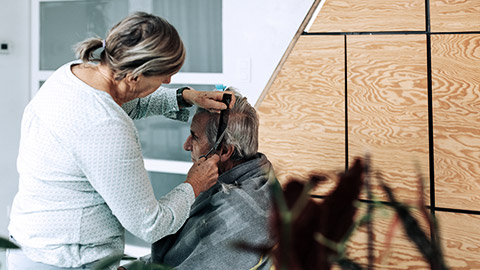
Each care situation and carer who cares for a person requiring support is unique (Victorian support for carers program, 2019).
It is therefore important to include carers and family members as well as the person needing care in the design and delivery of support services.
As we have established, the carer and family members will have a better understanding of the needs and wants of the person requiring care. Where people under care are unable to express their own thoughts, needs or feelings, the carer and/or family member is essential in passing on the needs of the person. They can also demonstrate the use of assistive technology or assistive communication tools where appropriate.
Gathering this knowledge and sharing information will ensure the support will be both beneficial and appropriate for the person in need, the carers and the family members.
Remember that carers are essential partners in the support network. They too can become ill or suffer emotionally if adequate support is not provided to them and require care for a short or long period.
Engage with the carer and family members
When first engaging with the carer or family members to develop a support plan, the first objective is to recognise and acknowledge the relationship between the carer, family member/s and the person in care. The support plan is then built around this relationship.
Part of the discussion will evolve around:
- Identifying and overcome some of the issues the carers or family members themselves have
- Identifying the strengths of the carers, family members and the person needing care
- Identifying the gaps in the carer or family members skills and knowledge and building in practices, training and activities to bridge or fill the gaps
- Ensuring the carer, family members and person receiving care is confident in the support plan and agrees to the actions.
Consider Cultural Needs
People from different cultural backgrounds can have beliefs and traditions around personal care routines that affect the way that you provide care. For example, they might require different types of dress, or they might feel embarrassed about some of their practices.
If the person’s social, cultural and spiritual differences do not harm anyone else, it is important that you respect and support them.
You can show respect for a person’s culture by:
- Trying to learn about their cultural differences, such as asking them or their family or researching the culture
- Helping the person practice their cultural and religious rituals
- Supporting the person to eat or dress according to their cultural preferences.
Benefits of inclusion of carer and family members
When you involve the carer/s and the family members in the design and delivery of a person’s support services these things happen:
Working on a plan
Part of the design of support services may involve planning the day-to-day activities of the person requiring support as well as fitting in with their carer and family member's daily needs and requirements.
When working out a plan in conjunction with all people involved you will need to consider:
- Adapting any activities to the individual needs of the person requiring care and those of the carer and family members
- Cultural sensitivities in suggesting services or activities
- Whether a formal analysis of the needs of the person under care is required
- Observing the reactions of carers and family in outlining required services and support. You need to ensure the carer and/or family members do not feel they are valued or of use to the person under care.
Approaches to involving carer and family members in planning
A support worker has a range of approaches that can be used to support a carer and ensure they feel they are an integral and essential part of the process of providing support for the person needing care.
Some of the approaches you might use involve:
- Always welcoming carers when they reach out to you as a support worker or support provider
- Providing information about support services and how they can be contacted and used
- Discussing and sharing information about carer and/or support worker rights and responsibilities
- Answering any questions put by the carer to the best of your ability – and finding out information or answers if you don’t know
- Simply, and with respect, explaining any rules and legal requirements about sharing information, privacy and confidentiality
- Promoting a carer-friendly culture within your support organisation so the carer can look after their own health needs
- Recognising carers know the people they care for better than anyone else. The information they provide may give clues as to how to work with the person requiring care
- Involving carers and family members in decision-making and care management wherever possible and applicable
- Actively listening to the carer and their concerns
- If applicable, refer the carer and the person requiring support to different support and information-sharing services
Activity – Case study and question
Case study

Lorenzo has dementia. He lives with his wife, Rosa, who is his carer.
Lorenzo’s needs include:
- helping him get out of bed in the morning
- showering
- toileting
- dressing
- ensuring his morning medication is taken
- administering the physiotherapy program to clear his lungs.
A portable hoist is available for the worker and carer to use to transfer him.
Rosa knows exactly how Lorenzo likes things to be done and in what order. She knows what to do and not do to keep herself and Lorenzo safe from harm or injury. When Lorenzo remembers he knows his preferences for how he wants to be treated – when he is not so sure, Rosa fills the gaps.
She has been doing all of these tasks as his carer (although she does not see herself in this role) for some time but is now unable to do so and has sought out help.
You want to work out a plan that will suit all three of you.
Question
Explain how you would go about developing the plan.
Post your ideas online or discuss them with your trainer and colleagues.
Importance of confirming the person’s preferences
The Aged Care Quality Standards expect you to talk to family members and carers of people needing care and the people with care needs themselves about what is in their plan. It is good practice to do this every day or each time you see them.
Remind the person needing care what is written in the plan and ask them if they are happy to follow the plan. If they would like to do anything differently that day, make allowances where possible to provide for the change.
Let the person know what it involves. For example:
- The person might not want to undertake that task or activity today
- Something might be more important for that person on that day, such as a medical appointment
- The person might be feeling down or have different needs.
If you are unsure about something in the plan, or have concerns, always check with the person first, and then your supervisor if you need further clarification. Sometimes the support that is outlined in the plan might not be appropriate at that time. Consider the potential impact that personal support may have on the person and confirm concerns with your supervisor.
Remember that in most cases, the client has the right to refuse care. When this happens, let your coordinator know, and then document the refusal in the your notes.
Work role boundaries
When you are working within an organisation it is essential you have a sound understanding of the relevant policies and procedures which apply to your work and how they are applied when you visit persons you will be caring for.
The policy and procedure under which you work will vary depending on:
- the type of work you do
- your work location
- the level of responsibility you have
- the autonomy of your position.
As a support person working with a person and helping them with their support needs, it can be tempting to do everything the person asks you to do. It is also tempting to do the things the carer or family member may do. Taking over another person’s task may lead to conflict and the carer or family member may feel they are inadequate or unable to help the person they are providing care for well enough.
It is important to maintain your professional boundaries and follow your service’s policies and procedures, even if the person needing care or the carer or family member asks you to do something differently.
You can refuse to do a task that breaches policy by being polite but firm. Explain to the carer, family member or person needing care that you are not allowed to perform that task. Let them know that you could get in trouble for breaking policy if you do.
Some benefits of following policy and procedure and working within designated boundaries include:
- Delivers a quality service based on guidelines and boundaries to persons needing care, carers and family members
- Assists in reducing stress related illnesses
- Provides guidance to work effectively with carers, family members and persons needing care to make informed decisions about care
- The expectations of the role of the support worker, carer, family member and person needing care is clearly set out and can be consistently applied.
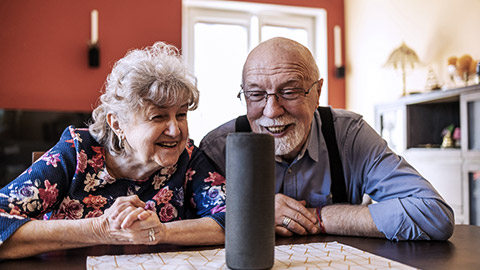
Assistive technologies is an ‘umbrella term covering the systems and services related to the delivery of assistive products and services’ (WHO 2018).
ATs range from low-technical devices such as a jar opener or walking stick to pressure care mattresses to minimise the potential for bed sores or a riser recliner chair to the more high-tech items such as voice-controlled/activated software for electronic devices.
The role of assistive technologies is to:
- enable a person to complete a task that they might otherwise find impossible or difficult to perform in a safe manner
- promote an individual/s well being by improving or maintaining their function and independence
- enable an individual to live a healthy, independent, productive and dignified life
- assist people with a cognitive or physical impairment to learn and achieve independence
- reduce the need for formal health and support services
- reduce the need for long-term care by carers.
As a support worker, you need to know and understand what AT solutions are available so you can offer advice or suggestions to carers or to persons who need care.
Activity – Watch some videos and answer the question
Watch the following videos.
Whilst these videos may show younger people at times, the videos demonstrate how AT can be used and applied in daily life to support the carer, support worker and person who needs care.
Opening the doors many paths to many destinations
Opening doors Cassandra’s story
Question
Reflect on the video content.
Post online or discuss with your trainer or colleagues one thing you have found interesting, confronting or you did not know before.
People in care who can benefit from assistive technologies include people:
- with mental health conditions such as autism or dementia
- who are elderly
- with a disability, cognitive or physical impairment
- with non communicable diseases such as stroke or diabetes
- who have gradual decline in body functions.
Types of ATs for different life domains
ATs are improving and changing all the time.
Activity – Research
Research to learn more about AT and the products available. The following websites will give you a start and provide a wide range of information about AT, funding models and services that can be offered to older people.
Assistive Technology Australia
Once you have completed some research and learned more about AT and the services available in Australia, list at least two assistive devices that you might recommend for older people in each of the following categories and why they might be used.
Selecting appropriate AT items
Selecting appropriate and useful assistive technology items requires careful thought and should be made in consultation with the following people:
- Carers
- Family members
- The person needing care
- Team of professionals including relevant family doctors, speech language pathologists, rehabilitation engineers, occupational therapists and other relevant specialists to the issue to be addressed
- Specialists from the companies manufacturing AT.
The ATiA (Assistive Technology Industry Association has a membership directory providing information about assistive technology and services from around the globe).
Consultation ensures the AT is going to be of benefit and is safe for the person needing care, the carers and family members or the support worker to use:
When thinking about whether AT is going to be appropriate and useful, consider:
- Why is the AT needed?
- What are the restraints that are needed or wanted to be overcome?
- What are the goals wanting to be achieved and how can AT help to reach the goals?
- What are the benefits, advantages and disadvantages of different brands or types of AT?
- Will the AT be able to be trialled to see if it meets the needs of the person requiring care?
- How can AT be accessed – through funding, renting or purchasing outright?
- Is any training or education required to use the AT competently?
- What are the follow up procedures for spare parts, servicing and repairs?

